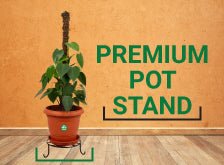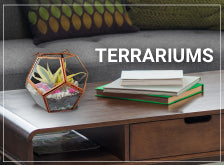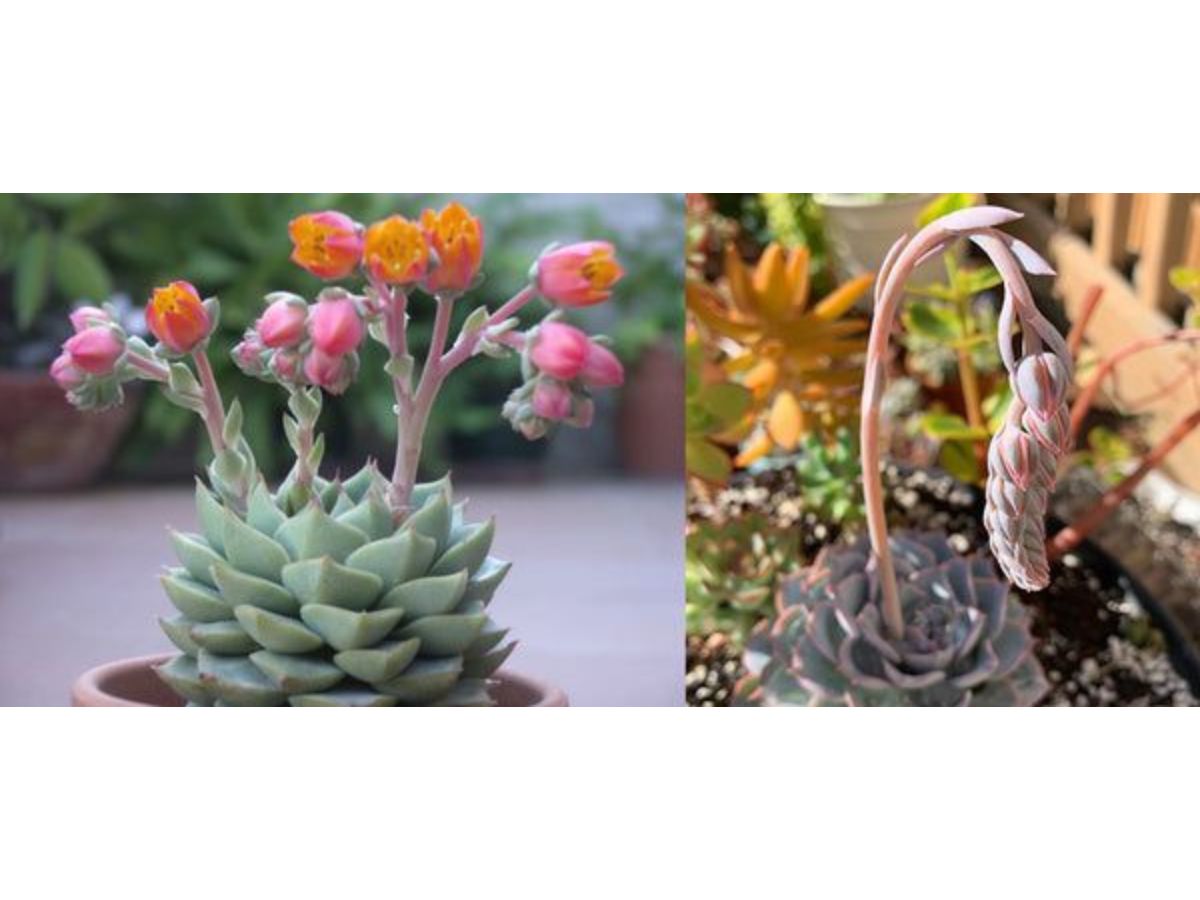How to Grow
Types of Succulents in India That Are Perfect Indoor Plants
Indoor plants are a great way to elevate the beauty of a home.
But isn't caring for these plants challenging given your busy schedule?
Life would be easier with plants that need infrequent watering and minimal care. The solution to this problem is a succulent garden.
Succulents have fleshy stems or leaves that store water, which is why you don’t need to water them regularly. They are usually hardy and require little care. Additionally, they are very flexible and would have little trouble adjusting to your household.
Do you know what succulents symbolize?
In the west, succulents often symbolize eternal love due to their ability to withstand harsh environments. In Asia, succulents are known to symbolize wealth and prosperity.
Today, we'll talk about the following in this blog:
- Why should you keep succulents indoors?
- Types of succulents in India that are perfect indoor plants
It is going to be an interesting read. So, let’s get started.
Why keep succulents inside the home?
Succulents are popular houseplants that have recently grown in popularity. The plants with fleshy stems are low-maintenance and can survive in extremely dry climates. This could be due to the fact that most succulents come from hot, humid, and dry climates in Africa and Central America.
You can keep succulents at your house if you're just starting off. Other persuasive justifications for having succulents at home include the following: -
Air purification
Succulents are effective at removing volatile organic compounds, or VOCs, from the air, according to various studies. These plants have the ability to release water vapor, which causes a pumping effect that draws contaminated air down to the plant's roots. The succulents also utilize these toxins to create their food. Simply put, keeping succulents improves the air quality in your house.
Elevates home décor
You've probably seen how Instagram's home décor bloggers decorate their spaces with a variety of succulents. This is due to the fact that many succulents have distinctive patterns on their stems, and some of them even bear flowers. They have an intriguing appearance and enhance a house's charm. You must incorporate succulents when remodeling your home.
Improves humidity
Succulents increase the amount of humidity inside a house by releasing water vapor. Many health conditions, including a sore throat, dry skin, common colds, and a dry cough, can be treated with this added moisture.
Low-maintenance plants
Succulents are the perfect plants for beginners who want to bring nature into their indoor spaces. They don't need a lot of water or light, so even if you're busy, it won't be difficult for you to take care of them. People who travel frequently should also consider buying succulents.
Adaptive in nature
Due to their hardiness, succulents are the perfect plants to bring home. Whether they are in the mountains or by the sea, they can quickly adapt to any climate. They thrive just as well in domestic settings as they do in outdoor landscapes. Additionally, they flower in their respective seasons.
Types of succulents in India that are perfect indoor plants
Do you know that there are over 10,000 varieties of succulents in the world? Also, succulents come in a variety of colors. India, with its hot and humid climate, is a perfect place to grow succulents. Here is a list of succulents in India that will be perfect as indoor plants for your home: -
Aloe Vera
Long before the word "succulents" gained popularity, aloe vera was already being planted in our homes. It is among the best-known houseplants in India. The fleshy stems that store useful gel are a blessing to humankind. Aloe vera gel is highly effective for treating any kind of skin or hair problem. Aloe vera is highly recommended to heal wounds and cuts, treat indigestion, boost immunity, and improve oral health.
Care Tip:
It needs direct, bright sunlight. The ideal soil for an aloe vera plant is one that is loose, rocky, and well-draining. In the summer, you can water it every three weeks, and it needs even less water in the winter.
Adenium
Adenium is a flowering plant species in the dogbane family. The dry climates of sub-Saharan Africa and the southern Arabian Peninsula are home to this small group of plants. Adenium is useful for treating wounds, getting rid of discomfort, lowering foot swelling, removing scabs, and preventing skin fungus.
Care Tip:
If you want big blossoms from an adenium plant, it needs 5 to 6 hours of direct sunlight per day. They favor a mix of cactus soil and lava rocks or grainy sand for optimal drainage. In the spring and summer, keep the soil moist, but in the fall and winter, reduce watering.
Snake Plant
The other names for snake plant are mother-in-law’s tongue or Sansevieria. They are one of the best indoor plants for their minimal requirements. Get rid of carcinogens like formaldehyde, benzene, xylene, CO2, etc. by bringing this succulent home. Additionally, these succulents produce oxygen at night, making your bedroom more comfy for you to sleep in.
Care Tip:
Typically, snake plants prefer direct, bright sunlight. They require water once every week in the summer and once every two months in the winter. Snake plants can flourish in soil that is nutrient-rich and well-drained.
Jade Plant
Jade plants are native to South Africa. They look cute with small almost round shaped leaves and a woody stem. They can filter the indoor air and produce oxygen even at night, offering you a pleasant atmosphere to sleep in. In South Africa, they are used to treat nausea, while in China, they are used to treat diabetes.
Care Tip:
The jade plant requires a loose, rocky, and well-draining soil to prosper. Remember to provide it with at six hours of sunlight daily and water it once every 2-3 weeks.
Burro’s Tail
Sedum Morganianum, also known as Burro’s Tail or Donkey’s Tail, is one of the best succulents to grow in India. It is from the Sedum genus in the family Crassulaceae. Perennial and evergreen plants originate from the southern regions of Mexico and Honduras. This succulent is known for its amazing foliage. This plant can grow up to four inches long, which resembles a tail, hence the unusual name.
Care Tip:
A mixture of potting soil (60%), perlite (15%), and coarse sand (25%), would work best for the growth of the burro's tail plant. Water this plant every 10 days. For the best-looking burro’s tail, opt for a place that receives bright, full sunlight.
Agave
The agave plant, which is native to the desert regions of Central America, South America, and Mexico, is distinguished by its fleshy leaves and prickly tips. They typically vary between blue-gray and blue-green colors. Agave has attractive bell-shaped white or yellow flowers. All parts of the agave plant can be used, but agave nectar is the product that is most frequently marketed. It might increase your metabolism, help you lose weight, and aid in your recovery from depression.
Care Tip:
Indoor agave plants should only be watered after the soil is fully dry. It grows on soil with good drainage. So for its growth, you can choose cactus soil. Agave can grow in both direct sunlight and partial shade.
Haworthia
They resemble aloe vera in appearance, but their stems feature white horizontal stripes instead. They also go by the name Zebra Haworthia for this reason. Their lovely leaves emerge from the stem in various directions. Because of its weak roots, this plant does best when planted in smaller pots. Bright yellow, conical flower heads on the zebra plant remain for about a week. It mostly serves to spruce up interior areas.
Care Tip:
Both direct and indirect sunlight are beneficial to Haworthia. This plant can withstand more medium-indirect light than other succulents. An excellent potting soil can be combined with equal parts of drainage materials such as aquarium gravel, perlite, poultry grit, or horticultural pumice. Haworthia requires watering every two to three weeks. It will need more water if you keep it in brighter light than if you keep it in shade.
Echeveria
Echeveria plants, also referred to as Hen and Chicks, are indigenous to the semi-desert regions of Central and South America. They are members of the Crassulaceae family, and like all succulents, they have fleshy leaves that store water. You can easily recognize them for their rose-shaped leaves. They are mostly used to elevate the beauty of gardens and the interior of homes.
Care Tip:
Echeverias need a minimum of six hours of bright, direct sunlight daily to thrive; otherwise, they will become elongated and won’t flower. A well-draining soil with a pH of at least 6.0 is best for this succulent. Create a cactus mix by mixing three parts ordinary potting soil, two parts coarse sand, and one part perlite for optimum Echeveria growth. Water it once a month in the winter and more regularly in the summer.
Flaming Katy
Flaming Katy is native to Madagascar and is a great indoor plant. It is a unique succulent that is cultivated largely for its vivid blooms. They are available in many hues, including pink, white, red, orange, and purple. When exposed to direct sunlight, the glossy, green leaves with scalloped edges can turn crimson. Flaming Katy can be a wonderful addition to your dining table, coffee table, or work desk.
Care Tip:
Flaming Katy requires eight to ten hours of bright sunlight daily to produce flowers and stay healthy. Water only when the soil has dried out completely. You should water once a week in the summer and once every two weeks in the winter. A soil with good drainage and a coarse texture is ideal. You can combine some organic compost with all-purpose succulent and cactus potting soil.
Panda Plant
A panda plant is easily recognized by its distinctively thick and velvety leaves. This Madagascar-native succulent perennial requires little maintenance. They have gray-green leaves with chocolate-brown edges and silver hair all over. Panda plants, also known as donkey ears, chocolate soldiers, white lady, pussy ears, cat ears, and plush plants, can reach heights of two feet.
Care Tip:
Water a panda plant only when the topsoil dries out completely. Therefore, it is advised to water every 5–6 days. Panda plants appreciate both partial shade and direct sunlight. For panda plants, the ideal soil should be abundant in water, air, minerals, and organic water. Therefore, use a blend of 60% potting soil, 15% perlite, and 25% coarse sand.
FAQs regarding Succulents
Can succulents grow in India?
Yes, succulents can easily grow in India. Because succulents thrive in warm and dry climates, and India provides that perfectly. Both as indoor and outdoor plants, succulents would grow well in the Indian climate.
Are succulents better in pots or on the ground?
Succulents can grow in pots as well as on the ground. However, compared to succulents grown in pots, those grown in soil are tougher and require less maintenance.
Do succulents need to be watered daily?
No. That’s because most succulents store water in their leaves or stems. So, you should wait for the topsoil to dry out before watering.
Ref Links:
https://www.ftd.com/blog/share/types-of-succulents
https://www.magicbricks.com/blog/indoor-succulent-plants/128917.html
https://gardeningtips.in/types-of-succulents-in-india-indoor-succulents-perfect-for-indian-climate
https://www.houzz.in/magazine/8-best-succulents-for-urban-indian-gardens-stsetivw-vs~90900519
https://gardentroubles.com/succulent-plants-india/
https://www.succulents.net/7-benefits-growing-succulents-home/
https://pharmeasy.in/blog/aloe-vera-gel-uses-and-uses/
https://elitechdrip.com/adenium-desert-rose/
https://www.webmd.com/diet/agave-health-benefits
https://www.masterclass.com/articles/agave-plant-guide
https://www.thesill.com/blog/how-to-care-for-haworthia
https://hort.extension.wisc.edu/articles/haworthias-super-succulents-for-small-spaces/#:~:text=Soil
https://www.thespruce.com/how-to-grow-echeveria-4778458
https://www.ourhouseplants.com/plants/flaming-katy
https://www.guide-to-houseplants.com/flaming-katy.html
https://www.masterclass.com/articles/panda-plant-care-guide
https://www.wildinteriors.com/blog/panda-plant-care#:~:text=Panda%20Plants%2C%20and%20all%20succulents,to%20dry%20in%20between%20waterings



